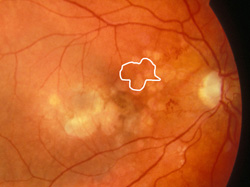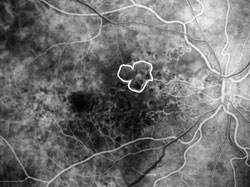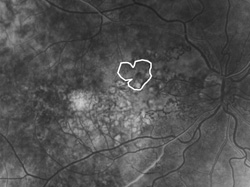The COMS Grading Scheme: Graded Features
Retinal capillary nonperfusion
Capillary non-perfusion is most apparent on angiogram as areas of hypofluorescence during the transit phase. Larger areas can visualized as “ground glass” appearing areas of hypofluorescence in the late phase, often with a surrounding area of mild hyperfluorescence. There can be no corresponding pigmented lesion or cotton wool spot in the color photograph. Capillary nonperfusion can only be graded when an angiogram is available. When capillary nonperfusion involves the foveal avascular zone (FAZ), the involved area is measured and 0.16 DA is subtracted to account for the physiologic avascularity of the FAZ.
Severity
back to COMS index





